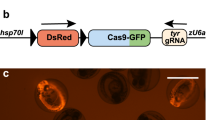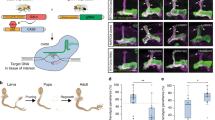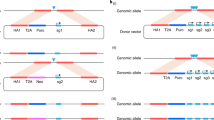Abstract
LARGE-SCALE chemical mutagenesis screens in zebrafish have led to the isolation of thousands of lethal mutations in genes that are essential for embryonic development1,2. However, the cloning of these mutated genes is difficult at present as it requires positional cloning methods. In Drosophila, chemical mutagenesis screens were complemented with P-element insertional mutagenesis which facilitated the cloning of many genes that had been identified by chemical lesions3,4. To facilitate the cloning of vertebrate genes that are important during embryogenesis, we have developed an insertional mutagenesis strategy in zebrafish using a retroviral vector. Here, in a pilot screen of 217 proviral insertions, we obtained three insertional mutants with embryonic lethal phenotypes, and identified two of the disrupted genes. One of these, no arches, is essential for normal pharyngeal arch development, and is homologous to the recently characterized Drosophila zinc-finger gene, clipper, which encodes a novel type of ribonuclease5. As it is easy to generate tens to hundreds of thousands of proviral transgenes in zebrafish6, it should now be possible to use this screening method to mutate and then rapidly clone a large number of genes affecting vertebrate developmental and cellular processes.
This is a preview of subscription content, access via your institution
Access options
Subscribe to this journal
Receive 51 print issues and online access
$199.00 per year
only $3.90 per issue
Buy this article
- Purchase on Springer Link
- Instant access to full article PDF
Prices may be subject to local taxes which are calculated during checkout
Similar content being viewed by others
References
Haffter, P. et al. Development 123, 1–36 (1996).
Driever, W. et al. Development 123, 37–46 (1996).
Cooley, L., Kelley, R. & Spradling, A. Science 239, 1121–1128 (1988).
Bier, E. et al. Genes Dev. 3, 1273–1287 (1989).
Bai, C. & Tolias, P. Mol. Cell. Biol. (in the press).
Gaiano, N., Allende, M., Amsterdam, A., Kawakami, K. & Hopkins, N. Proc. Natl Acad. Sci. USA 93, 7777–7782 (1996).
Burns, J. C. et al. Proc. Natl Acad. Sci. USA 90, 8033–8037 (1993).
Hopkins, N. Proc. Natl Acad. Sci. USA 90, 8759–8760 (1993).
Lin, S. et al. Science 265, 666–669 (1994).
Meisler, M. H. Trends Genet. 8, 341–344 (1992).
Altschul, S., Gish, W., Miller, W., Myers, E. & Lipman, D. J. Mol. Biol. 215, 403–410 (1990).
Dingerkus, G. & Uhler, D. L. Stain Tech. 32, 229–231 (1977).
Summers, M. F. J. Cell. Biochem. 45, 41–48 (1991).
Schilling, T. F. & Kimmel, C. B. Development 120, 483–494 (1994).
Westerfield, M. (ed.) The Zebrafish Book (Univ. of Oregon Press, Eugene, 1993).
Friedrich, G. & Soriano, P. Genes Dev. 5, 1513–1523 (1991).
Chen, J. et al. Meth. Mol. Genet. 4, 123–140 (1994).
Author information
Authors and Affiliations
Rights and permissions
About this article
Cite this article
Gaiano, N., Amsterdam, A., Kawakami, K. et al. Insertional mutagenesis and rapid cloning of essential genes in zebrafish. Nature 383, 829–832 (1996). https://doi.org/10.1038/383829a0
Received:
Accepted:
Issue Date:
DOI: https://doi.org/10.1038/383829a0
This article is cited by
-
Large-scale F0 CRISPR screens in vivo using MIC-Drop
Nature Protocols (2023)
-
A novel inducible mutagenesis screen enables to isolate and clone both embryonic and adult zebrafish mutants
Scientific Reports (2017)
-
Applications of CRISPR–Cas systems in neuroscience
Nature Reviews Neuroscience (2016)
Comments
By submitting a comment you agree to abide by our Terms and Community Guidelines. If you find something abusive or that does not comply with our terms or guidelines please flag it as inappropriate.



